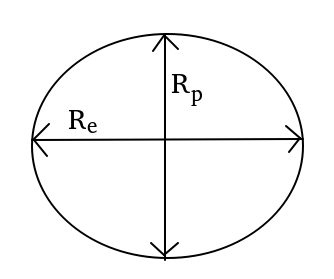
The value of ‘g’ on the surface of the earth is
A. Maximum at poles
B. Maximum at equator
C. Same everywhere
D. Minimum at poles
Answer
219.6k+ views
Hint: Solution can be found by observing the gravitational attraction formula, where gravitational force is inversely proportional to the distance from the center of the earth. Thus, extending it to the concept that Earth is not a perfect sphere and the distance of poles and the equator is different from the center of earth.
Complete step-by-step answer:
Gravitational attractive force felt by a body on the earth’s surface is given as;
$\overset{\to }{\mathop{F}}\,=\dfrac{GMm}{{{r}^{2}}}$
G is the gravitational constant
r is the distance from the earth’s center
M is the mass of the earth
M is the mass of the body.

We can observe from the above image that earth is not a perfect sphere. It is slightly bulged at the equator, and flattened at the poles. Thus, from the above diagram we can observe that;
$R_e > R_p$
where, $R_e$ is the diameter at the equator, $R_p$ is the diameter at the poles
We know from the gravitational attraction and thus the acceleration due to gravity ‘g’ becomes:
$\begin{align}
& g=\dfrac{GM}{{{r}^{2}}} \\
& \Rightarrow g\propto \dfrac{1}{{{r}^{2}}} \\
\end{align}$
Thus, for poles:
${{g}_{p}}\propto \dfrac{1}{R_{p}^{2}}$
Thus, for equator:
${{g}_{p}}\propto \dfrac{1}{R_{e}^{2}}$
So, since ${{R}_{e}}>{{R}_{p}},{{g}_{e}}$ will be less than ${{g}_{p}}$. That is, gravitational force and the ‘g’ will be maximum at the poles.
Therefore, the correct answer to this question is option A. That is ‘g’ is maximum at poles.
Note: The gravitational force is an attractive force that is, it always attracts and never repels. It never pushes two masses further, only a pulling force is generated. The ‘g’ is the acceleration of gravity and is equal to $9.8m/{{s}^{2}}$ at Earth surface, i.e., at sea level.
Complete step-by-step answer:
Gravitational attractive force felt by a body on the earth’s surface is given as;
$\overset{\to }{\mathop{F}}\,=\dfrac{GMm}{{{r}^{2}}}$
G is the gravitational constant
r is the distance from the earth’s center
M is the mass of the earth
M is the mass of the body.

We can observe from the above image that earth is not a perfect sphere. It is slightly bulged at the equator, and flattened at the poles. Thus, from the above diagram we can observe that;
$R_e > R_p$
where, $R_e$ is the diameter at the equator, $R_p$ is the diameter at the poles
We know from the gravitational attraction and thus the acceleration due to gravity ‘g’ becomes:
$\begin{align}
& g=\dfrac{GM}{{{r}^{2}}} \\
& \Rightarrow g\propto \dfrac{1}{{{r}^{2}}} \\
\end{align}$
Thus, for poles:
${{g}_{p}}\propto \dfrac{1}{R_{p}^{2}}$
Thus, for equator:
${{g}_{p}}\propto \dfrac{1}{R_{e}^{2}}$
So, since ${{R}_{e}}>{{R}_{p}},{{g}_{e}}$ will be less than ${{g}_{p}}$. That is, gravitational force and the ‘g’ will be maximum at the poles.
Therefore, the correct answer to this question is option A. That is ‘g’ is maximum at poles.
Note: The gravitational force is an attractive force that is, it always attracts and never repels. It never pushes two masses further, only a pulling force is generated. The ‘g’ is the acceleration of gravity and is equal to $9.8m/{{s}^{2}}$ at Earth surface, i.e., at sea level.
Recently Updated Pages
Two discs which are rotating about their respective class 11 physics JEE_Main

A ladder rests against a frictionless vertical wall class 11 physics JEE_Main

Two simple pendulums of lengths 1 m and 16 m respectively class 11 physics JEE_Main

The slopes of isothermal and adiabatic curves are related class 11 physics JEE_Main

A trolly falling freely on an inclined plane as shown class 11 physics JEE_Main

The masses M1 and M2M2 M1 are released from rest Using class 11 physics JEE_Main

Trending doubts
JEE Main 2026: Application Form Open, Exam Dates, Syllabus, Eligibility & Question Papers

Understanding Uniform Acceleration in Physics

Derivation of Equation of Trajectory Explained for Students

Hybridisation in Chemistry – Concept, Types & Applications

Understanding the Angle of Deviation in a Prism

Understanding Collisions: Types and Examples for Students

Other Pages
JEE Advanced Marks vs Ranks 2025: Understanding Category-wise Qualifying Marks and Previous Year Cut-offs

Units And Measurements Class 11 Physics Chapter 1 CBSE Notes - 2025-26

NCERT Solutions For Class 11 Physics Chapter 8 Mechanical Properties Of Solids

Motion in a Straight Line Class 11 Physics Chapter 2 CBSE Notes - 2025-26

NCERT Solutions for Class 11 Physics Chapter 7 Gravitation 2025-26

Understanding Atomic Structure for Beginners




